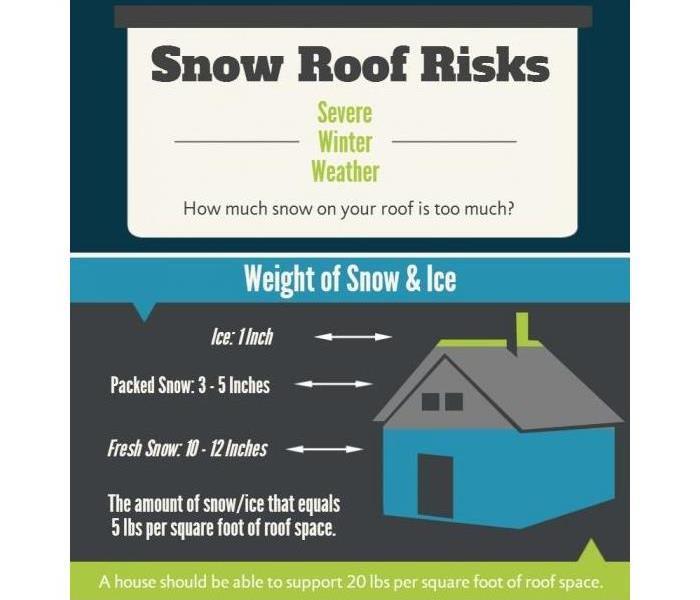Protect Homes from Winter Weather: Preventing Roof Damage
1/21/2020 (Permalink)
They say "knowledge is power." This is so true when it comes to homeownership!
Don't wait until winter weather has hit your hometown in full force to begin arming yourself with knowledge! Knowing what to do, what not to do, and when to do it are key pieces of information to have in any situation. With winter weather either already here and more snow and ice on the way, here are some tips for homeowners. Know what it takes to prevent roof damage from snow and ice.
1. Evaluate your risk! Melting snow tends to more quickly run off steep sloped roofs with slopes greater than 3" of slope in 12" of horizontal distance (3/12 pitch or greater), particularly the steeper ones that are typically found on houses in northern climates. Ice and snow tend to more readily accumulate on low slope and flat roofs over porches or parts of a home that are next to a taller section of the house, expecially during high winds.
2. Estimate how much weight your roof can support! Unless the roof structure is damaged or decayed, most residential roofs regardless of the location of the house should be able to support 20 pounds per square foot of snow before they become stressed. If you live in an area known for lots of snow, we recommend checking with your building department to find out of higher loads were used at the time your home was built, to see if your roof may be able to resister a greater depth of snow.
3. Estimate how much the snow on your roof weighs! Here are some general snow weight guidelines:
- Fresh snow: 10"-12: of new snow is equal to 1" of water, or about 5 pounds per square foot of roof space; so you could potentially have up to 4 feet of fresh snow before the roof will become stressed.
- Packed snow: 3"-5" of old snow is equal to 1" of water (5 lb/sq.ft. of roof space), so anything more than 2 feet of old snow could be too much for your roof to handle.
- Ice: 1" of ice equals 1 foot of fresh snow, or 1" of ice is equal to 1" of water, or about 5 pounds per square foot of roof space.
- Total accumulated weight: 2 feet of old snow and 2 feet of new snow could weigh as much as 60 pounds per square foot of roof space, which is triple the typical snow load capacity of most roofs!
4. Remove the snow from your roof! If the loads you estimate based on the thickness of various types of snow and ice exceed 20-25 pounds per square foot, you should consider removing snow from your roof. For safe removal that won't endanger you or damage your roof, hire a snow removal contractor who can safely remove the snow and ice.
These tips come courtesy of the Insurance Institute for Business & Home Safety.
If your home suffers damage from snow or ice on the roof which leads to water damage inside the structure, call on SERVPRO® of Glenview to come clean up the wet mess. 847-832-9300





 24/7 Emergency Service
24/7 Emergency Service
